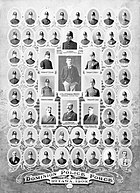Dominion Police
| Dominion Police Force | |
|---|---|
 Collage of the Members of the Police Force | |
| Agency overview | |
| Formed | May 22, 1868 |
| Dissolved | February 1, 1920 |
| Superseding agency | Royal Canadian Mounted Police |
| Jurisdictional structure | |
| Operations jurisdiction | Canada |
| Legal jurisdiction | |
| General nature | |
The Dominion Police Force was the
History
The Dominion Police was formed as the first
It was created on May 22, 1868, in response to the assassination of
Its primary functions were:
- protection of buildings of the Federal Government of Canada, including the Parliament Buildings on Parliament Hill,[b] the naval yards at Halifax and Esquimalt,
- providing bodyguards for government leaders,
- carrying out secret service work arising from the activities of the Fenian raids,
- enforcing certain federal laws such as those relating to and
- keeping the peace for specified railways and canals that were under construction when the Public Works Peace Preservation Act, 1869 was brought into force.[6]
They gradually also acquired responsibilities for compiling fingerprint and criminal records, and administering a parole service.[2][7]
In
In May 1918, the Dominion Police were reassigned to the
Structure
The Dominion Police consisted of Commissioners and constables appointed for that purpose, and its authority extended over the provinces and all parts of the territories not patrolled by the RNWMP. The organization was decentralized, with many Commissioners being appointed with either provincial or national responsibility, and it had two national co-commissioners until 1876. The national Commissioner also acted as the Commissioner of the Montreal Water Police, which reported separately to the
The commissioners that had responsibility for all of Canada were:
- Gilbert McMicken (1869-1871)[13]
- Hewitt Bernard (1871-1876)
- Charles-Joseph Coursol (1869-1876)[14]
- Zebulon Aiton Lash (1876-1880)
- Augustus Keefer (1880-1885)
- Sir Percy Sherwood (1885-1919)[2]
- Colonel Gilbert Godson-Godson (1919-1920)
From 1913, while Sherwood was the commissioner responsible for all of Canada, the title for this senior commissioner role was adjusted to Chief Commissioner, to whom all regional or departmental commissioners reported.
Ranks
The ranks of the Dominion Police were as follows:[15]
- Chief Commissioner ("chief" designation added 1913)
- Commissioner
- Inspector
- Sub-inspector
- Sergeant
- Constable
Further reading
- Van Blaricom, G.B. (October 1, 1909). "The Protectors of Royalty in Canada". The Busy Man's Magazine. Vol. 18, no. 6. Toronto. Archived from the original on February 28, 2022. Retrieved December 16, 2020.
- Ross, David; May, Robin (1988). The Royal Canadian Mounted Police, 1873-1987. Illustrated by Richard Hook. Boxley: Osprey Publishing. ]
- Williams, David Ricardo (1998). "7: Dominion Police". Call in Pinkerton's: American Detectives at Work for Canada. Toronto: Dundurn Press. pp. 115–134. ISBN 1-55002-306-3.
- Wilkinson, Robert (2005). "Canada's First Federal Police Force, 1864-1920" (PDF). The Thin Blue Line. 4 (2). BC Federation of Police Officers: 7–8. Archived from the original (PDF) on January 24, 2013. Retrieved September 25, 2014.
Notes and references
Notes
- United States Civil War, and later from the Fenian raids[1]
- ^ now protected by House of Commons and Senate Security Service Constables and Scanner operators
- ^ as the RNWMP were renamed In July 1919,[10] while the merger was only formally implemented in May 1920[11]
- ^ The Montreal Water Police would later fall under the responsibility of the National Harbours Board.
- ^ An Act respecting Harbor Police, S.C. 1868, c. 62 , later reconstituted as separate Harbour and River Police forces for Montreal and Quebec under An Act respecting the Harbour and River Police of the Province of Quebec, S.C. 1882, c. 48
References
- S2CID 142379170.
- ^ a b c Ross & May 1988, p. 17.
- ^ An Act respecting Police of Canada, S.C. 1868, c. 73 as amended by An Act to amend "An Act respecting Police of Canada", S.C. 1879, c. 37
- ^ Williams 1998, pp. 115–116.
- ^ as described in Attorney General of Alberta et al. v. Putnam et al., 1981 CanLII 206 at p. 293, [1981] 2 SCR 267 (28 May 1981)
- ^ An Act for the better preservation of the Peace in the vicinity of Public Works, S.C. 1869, c. 24
- ^ Williams 1998, p. 116.
- ^ An Act respecting Commissioners of Police, S.O. 1870-71, c. 16
- ^ a b "Canadian Army Military Police, 1914-1920". Canadian Military Police Virtual Museum. Archived from the original on February 28, 2022. Retrieved March 24, 2019.
- ^ An Act to amend the Royal Northwest Mounted Police Act, S.C. 1919, c. 69
- ^ An Act to amend the Royal Canadian Mounted Police Act and to transfer to the Commissioner of the Royal Canadian Mounted Police the powers heretofore vested in the Commissioner of the Dominion Police, S.C. 1920, c. 18
- ^ "Report of Commissioner of Montreal Water Police". Sessional Papers of the Parliament of the Dominion of Canada, Volume 4, Issue 3. 1871. pp. 107–110.
- ^ Previously head of the Western Frontier Constabulary. In 1871-1873, he was the Commissioner of Police for Manitoba.
- ^ Ste. Croix, Lorne (1982). "Coursol, Charles-Joseph". In Halpenny, Francess G (ed.). Dictionary of Canadian Biography. Vol. XI (1881–1890) (online ed.). University of Toronto Press.
- ^ "Canadian Military Police Civil Branch, The Dominion Police: Background - The Military Service Act, 1917". Retrieved May 13, 2021.
External links
- Royal Canadian Mounted Police at the Wayback Machine (archived June 22, 2011), Federation of American Scientists
- Dominion Police, 1868–1919, Library and Archives Canada
